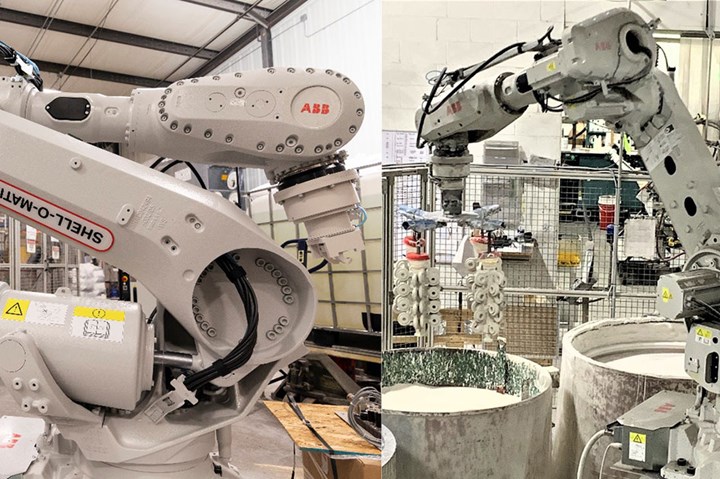Franklin Bronze Precision Continues Investment in Automation
Franklin Bronze Precision Components upgraded automation for its shell room, including a new robot arm, SCADA updates and RFID scanning capabilities.
#Industry40
Edited by Jenny Rush

Robot arm upon delivery (left) and in operation (right). Photo: Franklin Bronze Precision Components
Franklin Bronze Precision Components has conducted its next generation of automation upgrades for its shell room. Franklin Bronze Precision Components first introduced robots to their investment casting manufacturing processes in early 2005. It continues to stay ahead with its latest introduction of new robotic technologies.
Franklin Bronze kicked off 2020 by upgrading the robotic arm and supervisory system in shell room 2. The robot arm was replaced with a new state-of-the-art one, installed by Shell-O-Matic Inc.. Additionally, the SCADA (supervisory control and data acquisition) system, the operating platform, was upgraded to the newest version available. The upgrade allows for future growth and flexibility of Franklin Bronze’s investment cast shell room processes.
The new operating system provides more accurate identification of molds and parts with less manual manipulation, essentially allowing for quality protection of products during the production process, accoridng to the company. With this investment, Franklin Bronze implements Industial Industry 4.0 technology with the installation of first-of-its-kind automatic laser level adjustment, a technique said to be new to robots and automated investment casting foundries.
“The new robot arm, with the laser level adjustment, can automatically and instantly determine the level of slurry tank and will stop if it’s too low,” says Chris Barber, operations manager. "It senses the levels on its own and is a great example of Industrial Internet of Things, or IIoT, with its interconnected sensors triggering the robot to respond. It's a game-changer."
In addition to the laser level adjustment, RFID scanning was also installed. Radio-frequency identification or RFID scanning equips the robot to recognize and group like products together for an efficient mold shelling process in a short run time.
See a video of the robot in action here.
RELATED CONTENT
-
When to Introduce Automation Into Your Finishing System
Looking to increase productivity for your liquid coating operation? John Owed of Carlisle Fluid Technologies provides examples of how automation can help improve quality and efficiency for paint spray equipment.
-
Automation and Control of Electroless Nickel Baths
Spectrophotometric nickel/pH controller enables tighter control of the ENi process, resulting in improved product quality.
-
Data Collection Trends in Metal Finishing
The finishing industry is moving towards the automation of process and production data collection. Roger Smith outlines new technology to help finishers automate and streamline.
















